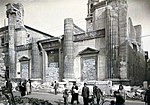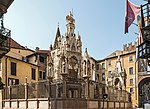San Fermo Maggiore, Verona
15th-century Roman Catholic church buildings in ItalyGothic architecture in VeronaRoman Catholic churches in VeronaRomanesque architecture in Verona

San Fermo Maggiore is a Romanesque and Gothic church in central Verona. It is dedicated to Saints Firmus and Rusticus, brothers who are local martyrs from the 3rd century. The exterior has a roofline with pinnacles, and the church once held the tomb of a member of the Scaligers. The interior has many medieval frescos, as well as later decoration, including the Brenzoni Monument (discussed below), an altarpiece of St Francis of Assisi by Giovanni Battista Belloti, whilst Veronese's Bevilacqua-Lazise Altarpiece was originally painted for a funerary chapel in the church. A crucifixion on the counter-façade is one of Turone's most significant works.
Excerpt from the Wikipedia article San Fermo Maggiore, Verona (License: CC BY-SA 3.0, Authors, Images).San Fermo Maggiore, Verona
Via Domenico Frangini, Verona Veronetta
Geographical coordinates (GPS) Address External links Nearby Places Show on map
Geographical coordinates (GPS)
| Latitude | Longitude |
|---|---|
| N 45.439166666667 ° | E 11 ° |
Address
Chiesa di San Fermo Maggiore
Via Domenico Frangini
37121 Verona, Veronetta
Veneto, Italy
Open on Google Maps









